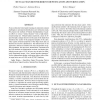Free Online Productivity Tools
i2Speak
i2Symbol
i2OCR
iTex2Img
iWeb2Print
iWeb2Shot
i2Type
iPdf2Split
iPdf2Merge
i2Bopomofo
i2Arabic
i2Style
i2Image
i2PDF
iLatex2Rtf
Sci2ools
ICASSP
2008
IEEE
2008
IEEE
Mutual features for robust identification and verification
Noisy or distorted video/audio training sets represent constant challenges in automated identification and verification tasks. We propose the method of Mutual Interdependence Analysis (MIA) to extract “mutual features” from a high dimensional training set. Mutual features represent a class of objects through a unique direction in the span of the inputs that minimizes the scatter of the projected samples of the class. They capture invariant properties of the object class and can therefore be used for classification. The effectiveness of our approach is tested on real data from face and speaker recognition problems. We show that “mutual faces” extracted from the Yale database are illumination invariant, and obtain identification error rates of 2.2% in leave-one-out tests for differently illuminated images. Also, “mutual speaker signatures” for text independent speaker verification achieve state-of-theart equal error rates of 6.8% on the NTIMIT database.
ICASSP 2008 | Mutual Features | Mutual Interdependence Analysis | Mutual Speaker Signatures | Signal Processing |
| Added | 30 May 2010 |
| Updated | 30 May 2010 |
| Type | Conference |
| Year | 2008 |
| Where | ICASSP |
| Authors | Heiko Claussen, Justinian Rosca, Robert I. Damper |
Comments (0)

